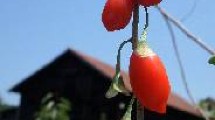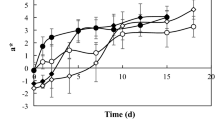Abstract
Due to availability of minimally processed products, the consumption of fresh produce has increased over recent years. The present study has been undertaken with the objective of screening of four mango cultivars (‘Kesar’, ‘Rajapuri’, ‘Totapuri’ and ‘Ladvo’) for evaluating the consequences of minimal processing on their quality attributes under storage at two different temperatures (5 ± 1 °C, 95% RH and 10 ± 1 °C, 87% RH) up to 12 days. The result of the study revealed significant impacts of low temperature storage on the quality parameters of fresh-cut mango cultivars. The evaluated bioactive compounds such as total phenolics, vitamin C and carotenoids were better retained in the samples stored at 5 °C as compared with that of 10 °C. Moreover, the storage of fresh-cut mango cultivars at 5 °C showed lower water loss and microbial contamination. Sensory analyses revealed that the storage of fresh-cut mango cultivars at 10 °C influenced overall acceptability due to changes in their visual perception, though taste, odor and firmness were less affected. This study revealed a significant variation in the storability of fresh-cut mango cultivars with respect to the storage temperature. Among currently studied four cultivars of mango, slices of ‘Totapuri’ showed comparatively the least change in color, firmness and sensory properties during storage at 5 and 10 °C and it can be a potential cultivar for fresh-cut processing.




Similar content being viewed by others
References
Ahmad I, Malik AU, Amin M, Anwar R (2007) Comparative studies on the performance to two commercial mango cultivars under ambient ripening conditions. Life Sci Int J 4:463–467
Allong R, Wickham LD, Mohammed M (2000) The effect of cultivar, fruit ripeness, storage temperature and duration on quality of fresh-cut mango. Acta Hort 509:487–494
Allong R, Wickham LD, Mohammed M (2001) Effect of slicing on the rate of respiration, ethylene production and ripening of mango fruit. J Food Qual 24:405–419
Amiot MJ, Tacchini M, Aubert SY, Oleszek W (1995) Influence of cultivar, maturity stage, and storage conditions on phenolic composition and enzymatic browning in pear fruits. J Agric Food Chem 43:1132–1137
Arauz L (2000) Mango anthracnose: economic impact and current options for integrated management. Plant Dis 84:600–611
Bico SLS, Raposo MFJ, Morais RMSC, Morais AMMB (2009) Combined effects of chemical dip and/or carrageenan coating and/or controlled atmosphere on quality of fresh-cut banana. Food Control 20:508–514
Dea S, Brechta JK, Nunes MCN, Baldwin EA (2010) Occurrence of chilling injury in fresh-cut ‘Kent’ mangoes. Postharvest Biol Technol 57:61–71
Degl’Innocenti E, Guidi L, Pardossi A, Tognoni F (2005) Biochemical study of leaf browning in minimally processed leaves of lettuce (Lactuca sativa L. var. Acephala). J Agric Food Chem 53:9980–9984
Gil MI, Aguayo E, Kader AA (2006) Quality changes and nutrient retention in fresh-cut versus whole fruits during storage. J Agric Food Chem 54:4284–4296
González-Aguilar GA, Celis J, Sotelo-Mondo RR, Rosa LA, Rodrigo-Garcia J, Alvarez-Parrilla E (2008) Physiological and biochemical changes of different fresh-cut mango cultivars stored at 5°C. Int J Food Sci Technol 43:91–101
Hardenburg RE, Watada AE, Wang CY (1986) The commercial storage of fruits, vegetables, and florist and nursery stocks. U.S.D.A., Agric. Handbook, Beltsville
Hodges DM, Toivonen PMA (2008) Quality of fresh-cut fruits and vegetables as affected by exposure to abiotic stress. Postharvest Biol Technol 48:155–162
Hodges DM, Wismer WV, Forney CF (2001) Antioxidant responses in postharvest leaves of two cultivars of spinach (Spinacia oleracea L.) differing in their senescence rates. J Am Soc Hortic Sci 126:611–617
Hossain MA, Rana MM, Kimura Y, Roslan HA (2014) Changes in biochemical characteristics and activities of ripening associated enzymes in mango fruit during the storage at different temperatures. BioMed Res Int. doi:10.1155/2014/232969
ICMSF (International Commission on Microbiological Specifications for Foods) (1978) Microorganisms in foods. I Their significance and methods of enumeration. University of Toronto Press, Toronto
Kim Y, Brecht JK, Talcott ST (2007) Antioxidant phytochemicals and fruit quality changes in mango (Mangifera indica L.) following hot water immersion and controlled atmosphere storage. Food Chem 105:1327–1334
Klein BP (1987) Nutritional consequences of minimal processing of fruits and vegetables. J Food Qual 10:179–193
Lim YY, Lim TT, Tee JJ (2006) Antioxidant properties of guava fruit: comparison with some local fruits. Sunway Acad J 3:9–20
Lima LCO, Chitarra AB, Chitarra MIF (2001) Changes in amylase activity starch and sugars contents in mango fruits pulp cv. Tommy Atkins with spongy tissue. Braz Arch Biol Technol 44:59–62
Litz RE (1997) The mango: botany, production and uses. CAB Int, Walling Ford
Lowry OH, Rosebrough NJ, Farr AL, Randall RJ (1954) Protein measurement with the Folin phenol reagent. J Biol Chem 193:27–52
Malik CP, Singh MB (1980) Plant enzymology and histo-enzymology. Kalyani Publishers, New Delhi, India
Mazumdar BC, Majumder K (2003) Methods on physico-chemical analysis of fruits. Daya Publishing House, Delhi, India
Nguyen-the C, Carlin F (1994) The microbiology of minimally processed fresh fruits and vegetables. Crit Rev Food Sci Nutr 34:371–401
Nunes MCN, Brecht JK, Morais AMMB, Sargent SA (1998) Controlling temperature and water loss to maintain ascorbic acid levels in strawberries during postharvest handling. J Food Sci 63:1033–1036
Papadakis SE, Abdul-Malek S, Kamdem RE, Yam KL (2000) A versatile and inexpensive technique for measuring color of foods. Food Technol 54:48–51
Plotto A, Goodner KL, Baldwin EA, Bai J, Rattanapanone N (2004) Effect of polysaccharide coatings on quality of fresh cut mangoes (Mangifera indica). Proc Fla State Hort Soc 117:382–388
Poubol J, Izumi H (2005) Shelf life and microbial quality of fresh-cut mango cubes stored in high CO2 atmospheres. J Food Sci 70:69–74
Rattanapanone N, Lee Y, Wu T, Watada AE (2001) Quality and microbial changes of fresh-cut mango cubes held in controlled atmosphere. HortScience 36:1091–1095
Robles-Sánchez RM, Islas-Osuna MA, Astiazarán-García H, Vázquez-Ortiz FA, Martín-Belloso O, Gorinstein S, González-Aguilar GA (2009) Quality index, consumer acceptability, bioactive compounds, and antioxidant activity of fresh-cut “Ataulfo” mangoes (Mangifera indica L.) as affected by low-temperature storage. J Food Sci 74:S126–S134
Roe JH, Oesterling MJ (1944) The determination of dehydroascorbic acid and ascorbic acid in plant tissues by the 2, 4-dinitrophenylhydrazine method. J Biol Chem 152:511–517
Romig WR (1995) Selection of cultivars for lightly processed fruits and vegetables. HortScience 30:38–40
Salinas-Hernández RM, González-Aguilar GA, Tiznado-Hernández ME (2015) Utilization of physicochemical variables developed from changes in sensory attributes and consumer acceptability to predict the shelf life of fresh-cut mango fruit. J Food Sci Technol 52:63–77
Saxena A, Bawa AS, Raju PS (2012) Effect of minimal processing on quality of jackfruit (Artocarpus heterophyllus L.) bulbs using response surface methodology. Food Bioprocess Technol 5:348–358
Sellamuthu PS, Denoya GI, Sivakumar D, Polenta GA, Soundy P (2013) Comparison of the contents of bioactive compounds and quality parameters in selected mango cultivars. J Food Qual 36:394–402
Tatsumi Y, Isogai M, Sei S (2006) Changes in ascorbic acid content and ascorbate metabolism-related enzyme activities during storage in cucumber (Cucumis sativus L.) and balsam pear (Momordica charantia L.). Acta Hort 712:755–761
Tomes ML (1963) Temperature inhibition of carotene synthesis in tomato. Bot Gaz 124:180–185
Tovar B, García HS, Mata M (2001) Physiology of pre-cut mango. II. Evolution of organic acids. Food Res Int 34:705–714
Wills R, Lee T, Graham D, McGlosson W, Hall E (1981) Post harvest—an introduction to the physiology and handling of fruits and vegetables. AVI, Westport, CT
Zhu ZJ, Zhan LJ (2010) Characterization of polyphenoloxidase from water caltrop (Trapa acornis Nakano) fruits. J Food Biochem 34:1125–1140
Acknowledgements
The authors are thankful to the Head, P.G. Department of Biosciences, Sardar Patel University, Gujarat, India for providing necessary facilities for carrying out this work.
Author information
Authors and Affiliations
Corresponding author
Rights and permissions
About this article
Cite this article
Sharma, S., Rao, T.V.R. Responses of fresh-cut products of four mango cultivars under two different storage conditions. J Food Sci Technol 54, 1689–1702 (2017). https://doi.org/10.1007/s13197-017-2601-0
Revised:
Accepted:
Published:
Issue Date:
DOI: https://doi.org/10.1007/s13197-017-2601-0




